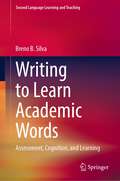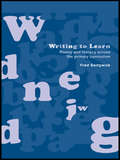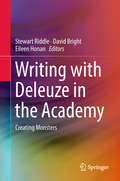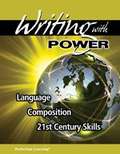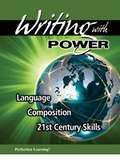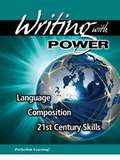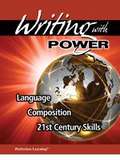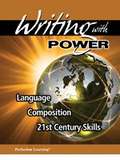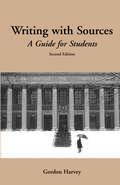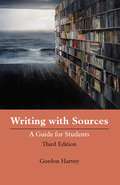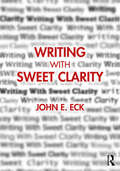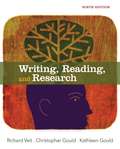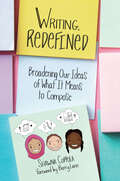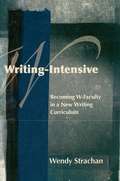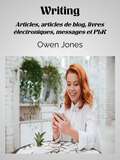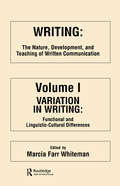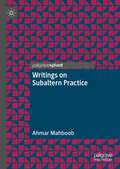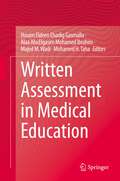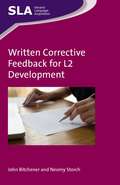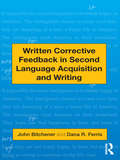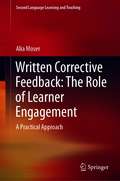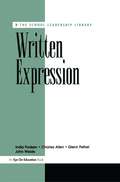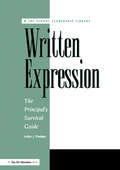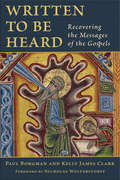- Table View
- List View
Writing to Learn Academic Words: Assessment, Cognition, and Learning (Second Language Learning and Teaching)
by Breno B. SilvaThis book highlights the importance of English academic vocabulary for success at university and explores written tasks as effective pedagogical tools to promote the acquisition of academic words. The book reviews germane and recent SLA, psycholinguistic, corpus linguistics, and L2 writing research to underscore the challenges associated with the learning of academic words. Then, it reports on three empirical studies conducted in the Polish context. The first study develops a reliable tool to assess the knowledge of academic vocabulary of undergraduate learners. The second and third studies investigate the learning of academic words after the writing of sentences and argumentative essays, and discuss the role of cognition as a mediator of such learning. The book also provides an accessible introduction to linear mixed-effect models, a powerful, reliable, and flexible statistical technique that has been gaining popularity among SLA and psycholinguistics researchers.
Writing to Learn: Poetry and Literacy across the Primary Curriculum
by Fred SedgwickWriting to Learn looks at how poetry can be used as an enjoyable way to teach literacy across the curriculum. It includes remarkable poems and stories by children as well as clear descriptions of how to teach creatively within the framework of the National Literacy Strategy. The book goes through the primary curriculum, subject by subject: *Poetry and Science and Maths *Poetry and Personal, Social and Moral Education *Poetry and Art and Music *Poetry and Religious Education *Poetry for its Own Sake. The author includes: *advice on different ways children can compose their writing and how computers can be a valuable aid to children's writing *examples of published poetry and how it can be used to stimulate good writing *advice on bringing writers into schools and publishing school anthologies. This book will prove invaluable to teachers and parents keen to teach writing whilst seeing children as active and critical learners. It shows that if we expect great things from children in writing, we get them.
Writing with Deleuze in the Academy: Creating Monsters
by Stewart Riddle David Bright Eileen HonanIn this book, authors working with Deleuzean theories in educational research in Australia and the United Kingdom grapple with how the academic-writing machine might become less contained and bounded, and instead be used to free impulses to generate different creations and connections. The authors experiment with forms of writing that challenge the boundaries of academic language, moving beyond the strictures of the scientific method that governs and controls what works and what counts to make language vibrate with a new intensity.The authors construct monstrous creations, full of vitality and fervor, hybrid texts, part academic part creative assemblages, almost-but-perhaps-not-quite recognisable as research. Stories that blur the lines between true and untrue, re-presentation and invention.The contributors to this book hope that something might happen in its reading; that some new connections might be made, but also acknowledge the contingency of the encounter between text and reader, and the impossibility of presuming to know what may be.
Writing with Power: Language Composition 21st Century Skills [Grade 10]
by Joyce SennNIMAC-sourced textbook
Writing with Power: Language Composition 21st Century Skills [Grade 11]
by Joyce SennNIMAC-sourced textbook
Writing with Power: Language Composition 21st Century Skills [Grade 12]
by Joyce SennNIMAC-sourced textbook
Writing with Power: Language Composition 21st Century Skills [Grade 8]
by Joyce SennNIMAC-sourced textbook
Writing with Power: Language Composition 21st Century Skills [Grade 9]
by Joyce SennNIMAC-sourced textbook
Writing with Sources: A Guide for Students
by Gordon HarveyDeveloped for Harvard University's Expository Writing Program, Writing with Sources describes the main principles and methods of integrating and citing sources in scholarly work, and provides cogent guidance on avoiding the misuse of sources.The second edition of Writing with Sources is updated throughout, and includes new material on the roles sources play in argument, on assessing the reliability of sources, and on attitudes about writing that can lead to plagiarism.
Writing with Sources: A Guide for Students
by Gordon HarveyThe challenges of integrating and citing sources in academic work have expanded in scope and complexity in the digital age, but the basic principles and guidelines for doing so responsibly remain the same. The third edition of Writing with Sources is updated throughout, providing more examples of the proper use and citation of digital and print sources across disciplines—including current conventions specific to MLA, The Chicago Manual of Style, APA, and CSE citation styles—while preserving its concise and accessible format.
Writing with Sweet Clarity
by John E. EckIn this book, criminologist and experienced educator John E. Eck draws on decades of academic and professional writing experience to provide an analytical toolkit for clear professional writing. This book focuses on the essential objective of clarity, and addresses topics seldom addressed in other books, such as ethics beyond plagiarism; writing with co-authors; organizing complex ideas; using analytics to improve writing; crafting strong beginnings and endings; using examples and metaphors; and integrating tables, charts, and diagrams. As universities continue to demand writing-intensive courses in the social sciences, this book is indispensable in university settings and throughout a professional career. The reader will use the practical advice, examples, and exercises in this book to master a method for clear writing unimpaired by stereotypical academic jargon. The book will help both new and seasoned researchers seeking to translate their work into a clear and accessible presentation for both professional and lay audiences. Designed for and field-tested with graduate and advanced undergraduate students, this lively and easy-to-read book will work for courses taught in criminology, sociology, geography, and other social sciences, and will enable scholars to extend and broaden the impact of their research.
Writing, Reading, and Research (9th Edition)
by Richard Veit Christopher Gould Kathleen GouldThis text is a composition course that prepares students for the tasks they will face during their college and professional careers developing skills in writing, reading and analyzing information.
Writing, Redefined: Broadening Our Ideas of What It Means to Compose
by Shawna CoppolaWhat does it mean to write or to be a writer? In Shawna Coppola's book Writing, Redefined: Broadening Our Ideas of What It Means to Compose, she challenges the reader to expand beyond standard alphabetic writing and consider alternative forms of composition when assigning writing to students. This book empowers teachers to change what counts as writing in schools and classrooms, opening the door to students who may not consider themselves to be writers, but should and can. Inside you'll find alternative, engaging writing assignments that are visual, aural, or multimodal that will involve all students, specifically those: Who prefer to compose using a wider array of forms and modes For whom standard English is not the norm Who have been identified as dyslexic Whose cultural traditions lean heavily towards more aural forms of composition Who are considered struggling writers By finding ways to accommodate all styles of writers, students are free to unleash their creativity and share their story with others. While there is no question composition in written form is important and worth of study, broadening our definition of writing expands an enormous range of possibilities for composing for all students.
Writing-Intensive: Becoming W-Faculty in a New Writing Curriculum
by Wendy StrachanIn one of the few book-length studies of a major post-secondary writing-across-the-curriculum initiative from concept to implementation, Writing-Intensive traces the process of preparation for new writing requirements across the undergraduate curriculum at Simon Fraser University, a mid-sized Canadian research university. As faculty members across campus were selected to pilot writing-intensive courses, and as administrators and committees adjusted the process toward full implementation, planners grounded their pedagogy in genre theory—a new approach for many non-composition faculty. So doing, the initiative aimed to establish a coherent yet rhetorically flexible framework through which students might improve their writing in all disciplines. Wendy Strachan documents this campus cultural transformation, exploring successes and impasses with equal interest. The study identifies factors to be considered to avoid isolating the teaching of writing in writing-intensive courses; to engender a university-wide culture that naturalizes writing as a vital part of learning across all disciplines; and to keep the teaching of writing organic and reflected upon in a scholarly manner across campus. A valuable case history for scholars in writing studies, WAC/WID, and curricular change studies.
Writing: Articles, articles de blog, livres électroniques, messages et PLR (Comment faire... #123)
by Owen JonesWriting Articles, articles de blog, livres électroniques, messages et PLR Plus de gens écrivent maintenant qu'à n'importe quel moment de l'histoire de la civilisation. Ceci est principalement dû à l'éducation et à plus de temps libre. La génération des parents des baby-boomers était la première génération de lecteurs de masse – certainement en Occident, et probablement dans le monde. Leurs parents savaient lire, en général, mais n'avaient aucune tradition de lecture de livres. Au lieu de cela, ils lisent surtout des journaux. Leurs enfants ont eu une meilleure éducation et ont repris l'habitude de lire de leurs parents. Ils ont également été encouragés à lire des livres à l'école. La première génération où cela s'est produit. Leurs enfants, les baby-boomers de l'après-guerre, ont continué la progression et sont devenus des lecteurs avides. À cette époque, il n'y a pas si longtemps, disons entre soixante-dix et trente ans, les gens écrivaient des lettres à la main. Ce fut une expérience personnelle longue mais très agréable. Ensuite, l'ordinateur personnel, le courrier électronique et Internet ont commencé à se répandre parmi les masses, et la plume et l'encre ont progressivement été remplacées par des babillards électroniques, des publications sur des forums et des e-mails. Avant ce point, l'écriture avait été un événement spécial pour la plupart des gens... des lettres de remerciement, des cartes postales, des cartes d'anniversaire et l'étrange lettre personnelle à la maison ou à un ami. L'ordinateur personnel permettait d'envoyer facilement une note rapide à quelqu'un. Il a fallu beaucoup moins de temps pour écrire et livrer, ou se faire livrer par la poste. Soudain, tout le monde a commencé à écrire et à publier pour sa famille, ses amis, des inconnus et même des ennemis. Une barrière avait été levée – des barrières de temps et de formalité,
Writing: The Nature, Development, and Teaching of Written Communication
by M. Farr WhitemanFirst Published in 1982. Routledge is an imprint of Taylor & Francis, an informa company.
Writings on Subaltern Practice
by Ahmar MahboobSubaltern theory emerged as a small voice within academia decades ago. Over time, this work generated significant debate and numerous publications, talks, and conferences. However, little has changed in the experienced lives of the masses. This led people to wonder: “the subalterns seem to have a voice, but can they take action?”; or, in other words, is there subaltern practice?This collection of essays and poems, written with a broad audience in mind, hopes to demonstrate not just how the subaltern can identify and question hegemonic practices, but how they can create alternative frameworks and material that enable themselves and their communities. In doing so, this book aims to demonstrate not just how deep the colonial poisons run, but also how to detoxify ourselves and the environment around us.The writings included in this book study the inequalities that we experience in and around us and suggest actions and practices that can help us regain harmony. It is a call for action and a sharing of ideas that can enable us to regain balance and fulfil our human responsibilities.
Written Assessment in Medical Education
by Hosam Eldeen Elsadig Gasmalla Alaa AbuElgasim Mohamed Ibrahim Majed M. Wadi Mohamed H. TahaThis book is an indispensable yet simple reference for the daily use of a medical teacher. It addresses the needs of medical teachers interested in providing instruction and assessment in writing and written language, offering detailed guidance in simple and straightforward language. The book goes beyond mere description; it provides many practical examples, valuable materials that can be utilized in training workshops and medical educator professional development courses. The book will be of interest to novice and experienced teachers in medical schools, in addition to university teachers in other health professions, such as dentistry, pharmacy, nursing, medical laboratory, physiotherapy, biomedical engineering and veterinary medicine.
Written Corrective Feedback for L2 Development
by Neomy Storch John BitchenerWritten corrective feedback (CF) is a written response to a linguistic error that has been made in the writing of a text by a second language (L2) learner. This book aims to further our understanding of whether or not written CF has the potential to facilitate L2 development over time. Chapters draw on cognitive and sociocultural theoretical perspectives and review empirical research to determine whether or not, and the extent to which, written CF has been found to assist L2 development. Cognitive processing conditions are considered in the examination of its effectiveness, as well as context-related and individual learner factors or variables that have been hypothesised and shown to facilitate or impede the effectiveness of written CF for L2 development.
Written Corrective Feedback in Second Language Acquisition and Writing
by John Bitchener Dana R. FerrisWhat should language and writing teachers do about giving students written corrective feedback? This book surveys theory, research, and practice on the important and sometimes controversial issue of written corrective feedback, also known as “error/grammar correction,” and its impact on second language acquisition and second language writing development. Offering state-of-the-art treatment of a topic that is highly relevant to both researchers and practitioners, it critically analyzes and synthesizes several parallel and complementary strands of research — work on error/feedback (both oral and written) in SLA and studies of the impact of error correction in writing/composition courses — and addresses practical applications. Drawing from both second language acquisition and writing/composition literature, this volume is the first to intentionally connect these two separate but important lines of inquiry.
Written Corrective Feedback: A Practical Approach (Second Language Learning and Teaching)
by Alia MoserThe book provides new insights into written corrective feedback by describing students’ expectations as well as mediating factors that influence their engagement with it. The book draws on an extensive dataset to illustrate secondary school students’ behavioural, cognitive and emotional engagement with written corrective feedback and the extent to which mediating factors, such as teachers, peers, feedback options, attitudes and emotions, foster or hinder it. It shows why teachers need to provide students with the purpose of the corrective feedback they provide, explain how such feedback works and introduce strategies that can be employed to engage with it. Based on the finding that a combination of several feedback types is essential to ensure learner engagement, the book also provides an extensive description and multiple authentic examples of the Engagement-Feedback-Mediator Model that was developed in the context of this study.
Written Expression
by Charles Allen India Podsen Glenn PethelThis book offers concrete advice and handy examples to sharpen your writing skills. Filled with sample letters, memos, and reports (also available on an accompanying disk with workbook), this book will help you successfully attack your in?basket. The writing samples are organized according to the particular audience you want to reach: faculty and staff, parents, central office, peers, local community, etc.
Written Expression Disk with Workbook
by India PodsenThis workbook provides principals with the tools they need to put into practice the concepts outlined in Written Expression: the Principal's Survival Guide, a volume in Eye On Education's hardcover series, The School Leadership Library. The workbook expands the topics covered in the hardcover book and provides additional examples. On the diskette you will find many of the sample documents printed in both the hardcover book and this workbook. You may use these files as templates for your own writing tasks.
Written to Be Heard: Recovering the Messages of the Gospels
by Kelly James Clark Paul BorgmanRecovers the lost messages of Mark, Matthew, Luke-Acts, and John for people todayThe words of the gospels were meant to be heard. While we can still appreciate the construction and grasp some understanding when we read, we miss much of the message because we&’re working in the wrong medium. In Written to Be Heard Paul Borgman and Kelly James Clark offer the keys to recovering the radical, relevant messages of each gospel as they were first heard.The shaping of the gospels for oral performances, which would have been obvious to ancient (mostly preliterate) listeners, is lost on even the best contemporary reader. With careful analysis of the gospel writers&’ particular voices within their own ancient literary context, Borgman and Clark equip readers to read as if hearing, focusing on overlapping patterns of hearing cues that shape each text and embed theological perspective.
Written to Be Heard: Recovering the Messages of the Gospels
by Kelly James Clark Paul BorgmanRecovers the lost messages of Mark, Matthew, Luke-Acts, and John for people todayThe words of the gospels were meant to be heard. While we can still appreciate the construction and grasp some understanding when we read, we miss much of the message because we’re working in the wrong medium. In Written to Be Heard Paul Borgman and Kelly James Clark offer the keys to recovering the radical, relevant messages of each gospel as they were first heard.The shaping of the gospels for oral performances, which would have been obvious to ancient (mostly preliterate) listeners, is lost on even the best contemporary reader. With careful analysis of the gospel writers’ particular voices within their own ancient literary context, Borgman and Clark equip readers to read as if hearing, focusing on overlapping patterns of hearing cues that shape each text and embed theological perspective.
